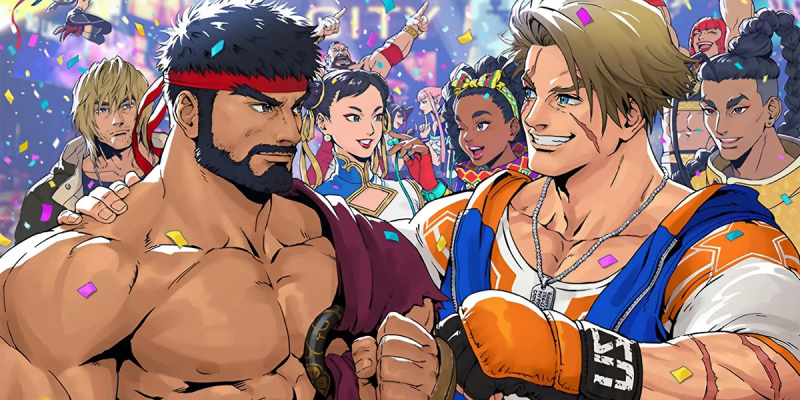Do you love something that you suck terribly at despite its many efforts to push you away? The answer is probably a resounding “yes” and applied to more than one thing. In that case, I salute you, fellow human being. When it comes to the paradox of being bad at something that I love in the realm of video games, I’ve already discussed my love-hate relationship with MOBA titles and how Predecessor gave me exactly what I wanted. Well, six months into 2023, the same thing has happened with Street Fighter 6 telling me everything will be alright even though I’m bad at fighting games.
This year is shaping up to be a great one for fighters, with SF6 clicking with a far larger community than its predecessors and Mortal Kombat 1 and Tekken 8 promising to be more than adequate new iterations of long-running series. Tournament fanatics are eating good, but what about us eternal noobs?
I personally never had much trouble pulling off specials and satisfactory combos in Mortal Kombat and Tekken (among others), mainly because their control schemes and overall combat pacing never went overly technical. But I always struggled with Street Fighter and King of Fighters, failing to consistently execute even the simplest button combinations. Mind you, I’m not amazing at the fighters I mentioned first, but I can manage myself. And that only makes my overall suckage at SF and KoF more painful.

Image via Capcom
Has Street Fighter 6 magically made me a high-ranking player? No, but it sure has encouraged me to learn the ropes in more effective ways than its predecessors. Starting with the beta, I was surprised by how accessible yet not dumbed down the new Modern control model was. It simply makes sense and feels intuitive, something I honestly can’t say about half-circles and multi-button inputs only to cast a single ranged attack. Does this take away from the experience? Not at all, because I wasn’t in the experience to begin with.
Modern controls don’t feel like cheating or “Street Fighter for toddlers” either. The more approachable Marvel vs. Capcom series already toyed with simpler controls, yet turning them on always felt like they were taking the most complicated toys away from you instead of making them make sense. But you could kick ass — at least in casual play — by mashing buttons, so that was half-cool. The Modern controls in SF6, on the other hand, allow you to share the playground with the big boys without feeling embarrassed.

Image via Capcom
Leaving the older controls behind doesn’t erase raw skill and correct timing either, but that’s something that every seasoned player into action-heavy games should be able to handle. But of course, there’s a huge difference between going “well, go into the tutorial mode for as long as you need” and actually easing newcomers into the ins and outs of a new Street Fighter installment. While other veteran series are content with spelling out the basic inputs and a handful of combos and specials before throwing players into the meat grinder, Street Fighter 6 built an entire actually fun mode around a fighter’s journey to the top ladder.
World Tour is much more than SF6’s take on the semi-open-world campaign structure that Mortal Kombat: Deception already tried almost 19 years ago. It’s another way to fix the gap between folks already into Street Fighter and players that want to “git gud” just enough to join the fun and last more than a couple of days fighting online. The big risk here was inadvertently making the entire mode a glorified tutorial – something that happens far too often with story modes in fighters – but World Tour is a rather breezy experience that encourages experimentation and self-improvement, all while using the vast array of moves and fighting styles available in the game.

Image via Capcom
This “main course” mode also works on a meta-level, with the player’s custom toons representing the newcomers that Street Fighter (as a franchise) wants to recruit, while major characters act as mentors and the “old guard” who’s been making an art out of fighting for a long time.
Most fanatics always jump straight into ranked online matches with their “mains,” so training with and impressing the veteran characters ultimately feels like graduating from high school before getting into the college or university where the cool kids are. World Tour can technically become a grind, but it also comes across as a relaxed bizarro world where refrigerators, ninjas, office workers, and street gangs with a poor sense of fashion are just hanging around the streets waiting for a good fight.
I’m far from reaching “the end” of World Tour, but it feels like a safe space (in spite of all the high-level encounters later on) where I can chill and fight under less pressure, all while coming across zany NPCs and buying hideous pieces of clothing. It’s got that offbeat, totally silly Yakuza personality that we don’t see much of anymore in open worlds.

Image via Capcom
As you can tell, I’m still getting the hang of Street Fighter 6, and I haven’t even joined the colorful online Battle Hub lobbies. However, I’m loving my time with this entry because it cares about every kind of player. And that extends to the overall vibes, with the game presenting itself as this very social experience for people who love fighting for sport instead of making real enemies.
For a game about smacking the shit out of each other, SF6 is surprisingly peaceful and uplifting. Even the Arcade story endings — told in a simple manner through panels — rarely feel high-stakes and aggressive. It’s refreshing to see a fighter embracing much of that easygoing Splatoon energy that made a shooter attractive for millions of players who loathed pew-pew gameplay. I hope more games built around violence (no matter the genre) can learn something from these spiritual and practical experiments.
